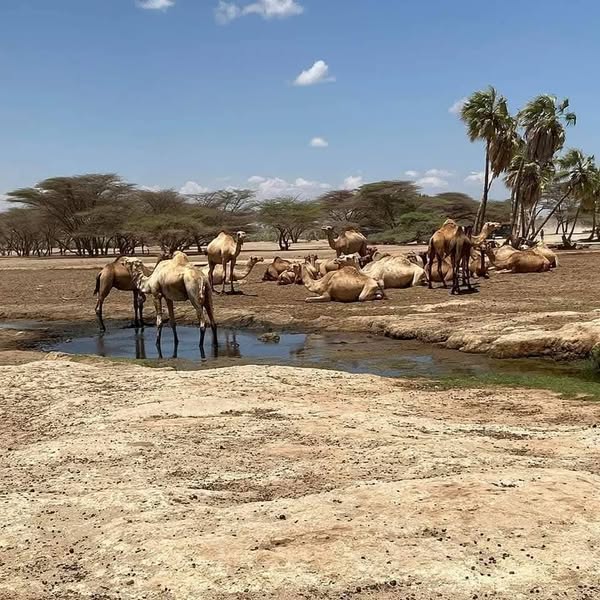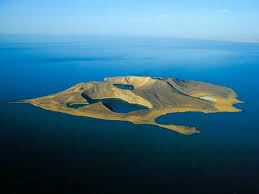Unveiling the Jade Sea Gateway: Your Ultimate Guide to the Chalbi Desert Expedition
The Chalbi Desert, a vast, shimmering expanse in Northern Kenya, is the only true desert in the country and a critical stop on any expedition to the remote Lake Turkana (the "Jade Sea"). Its name, meaning "bare and salty" in the local Gabbra language, perfectly captures its otherworldly beauty and its profound challenges.
For the intrepid traveler, crossing the Chalbi is a rewarding journey into the heart of Kenya's rugged northern frontier, offering unique cultural encounters and starkly beautiful landscapes.
Key Facts & What You Will See
|
Feature |
Details |
|
Size & Location |
The Chalbi Desert covers approximately 100,000 square kilometers (or about $38,600$ sq mi) in Marsabit County, stretching towards the Ethiopian border. It lies east of Lake Turkana. |
|
Origin |
It is an ancient, dried-up lake bed, a geological wonder composed of coarse sand, pure rocks, immense clay, and salt pans. |
|
What to See |
Shimmering Salt Flats: Vast, flat, cracked earth that creates breathtaking optical illusions and mirages, especially when dry. Volcanic Hills: The desert is surrounded by ancient volcanic craters and lava flows, creating a dramatic, contrasting panorama. Kalacha Oasis: A surprising, palm-fringed oasis on the edge of the desert, serving as a vital water source and a center for the local Gabbra community. Stark Beauty: The intense heat, red soil, and endless, dramatic horizons are a photographer's dream. |
|
The Journey to Turkana |
The Chalbi Desert is the final, challenging stretch before reaching the eastern shores of Lake Turkana, notably the town of Loiyangalani, home to the annual cultural festival and gateway to Sibiloi National Park. |
Wildlife and Communities: Life in the Extreme
Despite the harsh environment, life has found a way to thrive in and around the Chalbi Desert.
Desert Wildlife: The Adapted Few
Wildlife sightings are less about mass herds and more about spotting highly adapted species surviving in one of the hottest climates in Kenya. Keep an eye out for:
- Grevy's Zebra: The largest and most threatened of the zebra species, endemic to Northern Kenya.
- Beisa Oryx: A large antelope with long, straight horns, perfectly adapted to the arid climate.
- Somali Ostrich: Distinguished by its blue neck and legs.
- Reticulated Giraffe: A visually stunning subspecies, often spotted near the edges of the desert.
The Resilient Communities
The desert is home to several nomadic pastoralist tribes whose ancient knowledge is key to navigating this landscape.
- Gabbra: A semi-nomadic community whose language gives the desert its name. They are predominantly found in the eastern part, relying on camels for transport and survival.
- Rendille: Primarily live on the southern edges of the desert, also known for their camel herding traditions.
- Turkana & El Molo: Found further west, particularly around the shores of Lake Turkana. A cultural tour offers invaluable insight into their survival strategies, beadwork, and unique ways of life.
Challenges and Dangers of the Chalbi Crossing
The Chalbi Desert is a true wilderness destination that demands respect, meticulous planning, and an experienced guide.
1. Extreme Climate and Dehydration
- Danger: Daytime temperatures frequently soar past $40 celsius ($104F) with intense sun and high winds. Dehydration and sunstroke are major risks.
- Mitigation: Carry vastly more water than you think you need. Wear loose, light-colored clothing, a wide-brimmed hat, and strong sunscreen.
2. Vehicle Breakdowns and Getting Stuck
- Danger: The terrain is unpredictable, shifting from hard-cracked earth to soft sand dunes and sudden rocky lava flows. Vehicle breakdowns are common due to the rugged conditions, and getting stuck in soft sand is a high probability.
- Mitigation: Only travel in a well-maintained 4x4 safari vehicle (usually a Land Cruiser). Ensure you have spare tires, recovery gear (shovels, sand ladders, tow ropes), and a knowledgeable driver/guide experienced with desert driving.
3. Navigational Hazards
- Danger: There are virtually no road signs or permanent landmarks across the main salt pan. Tracks can shift or disappear entirely after wind or rain.
- Mitigation: Never attempt to cross without a professional local guide who knows the current tracks and weather conditions. GPS and satellite communication devices are essential.
4. Flash Flooding (Seasonal)
- Danger: Although a desert, the flat, baked-clay pan cannot absorb water quickly. During and immediately after the short and long rainy seasons (April-June and November-December), the desert can flood, becoming an impassable expanse of sticky, deep mud that can trap vehicles for days.
- Mitigation: Check seasonal weather conditions rigorously. Tours usually avoid the crossing entirely during the peak rainy months. If the track is wet, use an alternative, longer transit route.
Safety and Practical Tips for Your Expedition
- Go Guided: This is the most critical safety advice. Book your trip through a reputable safari operator who provides a robust, fully-equipped 4x4 vehicle, an experienced driver, and reliable communication gear.
- Communication: Have a satellite phone or high-frequency radio, as mobile phone reception is non-existent for long stretches.
- Emergency Plan: Ensure your operator has a clear emergency protocol and a support network in the nearest towns (Marsabit, Loiyangalani, or North Horr).
What to Do If Stuck or Car Breaks Down:
- Stay with the Vehicle: Your vehicle is the most visible object for rescue and provides essential shade from the sun. Do not wander off.
- Signal for Help: Use your satellite communication device immediately.
- Conserve Resources: Ration water and food strictly. Minimize activity to reduce heat and dehydration.
- Get Shade: Erect a tarpaulin or use the vehicle doors to create additional shade. Your experienced guide will know the best immediate actions to take.
Connecting to Lake Turkana
The Chalbi Desert is a spectacular but demanding prelude to the "Jade Sea." The primary destinations connecting the two are:
- Loiyangalani: A small town on the southeastern shore of Lake Turkana, serving as the cultural and tourism hub for the eastern side.
- Sibiloi National Park: Located further north, famed as the "Cradle of Humankind" for its hominid fossil sites (Koobi Fora).
A journey through the Chalbi Desert is a unique, unforgettable experience that tests the limits of both man and machine, offering an intimate look at a truly raw and majestic corner of the world.




